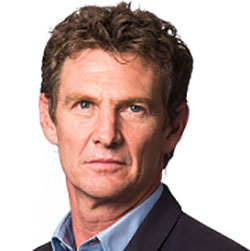 At a recent media briefing in London, Jason Goodall, CEO, NTT Ltd outlined his goals and targets for the newly formed NTT Ltd. One of those is to consolidate the position of NTT Ltd as the third largest data centre company in the world. As part of that consolidation, Goodall announced that NTT Ltd is to invest $7 billion in new and upgraded facilities.
At a recent media briefing in London, Jason Goodall, CEO, NTT Ltd outlined his goals and targets for the newly formed NTT Ltd. One of those is to consolidate the position of NTT Ltd as the third largest data centre company in the world. As part of that consolidation, Goodall announced that NTT Ltd is to invest $7 billion in new and upgraded facilities.
Driving this investment is a move to meet aggressive turnover targets from NTT Inc, NTT Ltd’s parent company. Goodall revealed that the various brands that have come together to make up NTT Ltd had a combined turnover of $11bn in 2018. By 2023, the target is $15bn.

To reach that target, the integration of all the business units needs to proceed without impact customers. It also needs to deliver new value, something that Goodall said would come from cross-selling. This is an area that could yield significant benefits. Until now, the various subsidiaries have competed against each other, even when they were selling white-labelled versions of each others products.
For that cross-selling to succeed, NTT Ltd needs to focus on where the opportunities are. According to Goodall, this means transforming the company to become a services led business. It already has a large services portfolio that delivered 30% of the revenue in FY2018. By FY2023 it expects to see services deliver 50% of revenue. That’s a significant growth and one that is expected to come while the existing parts of the business also continue to grow.
Four key markets to hit the FY2023 target
Goodall identified four attractive markets that are the focus of the new NTT Ltd portfolio. They are:
- Data Centre
- Managed Services
- Networks
- Security
Gaining market share is not going to come through a discounting war. NTT Ltd expects to keep at least a 10% + OP Margin. It will be interesting to see how it achieves that. While the services market is growing rapidly margins are coming under pressure, especially from the bigger players. This is where Goodall’s plan to cross-sell the existing customer base comes into play.
Existing customers know what they are getting. However, during the era of competitive selling, they were subjected to different companies in the group coming in and making sales pitches. Going forward, that will no longer happen.
Goodall and his senior sales team claim that this is not about reducing choice for customers. The plan is to provide customers with a much wider portfolio of products with more consistency in the sales cycle. It will see customers having a single point of contact in the sales cycle. They will also get a single support system. This will streamline the customer engagement and remove frustration from some customers.
$7 billion for data centres to secure the future
When NTT Ltd came into existence on July 1st, it merged all the assets from the various business units. In the data centre space, this made it the third largest operator of data centres in the world. It currently has more than 5 million square metres of data centre space. To stay there, and to provide a physical platform for the push into services, Goodall announced that it would invest $7 billion in its data centre estate. This is a necessary expense if NTT Ltd is to provide a physical delivery point for its push into services.
The company also needs to balance its existing data centres to ensure that it can serve equally all its markets across the globe. At present, its biggest concentration (47%) of data centres is in the APAC region. This is followed by EMEA (27%), US (18%) and India (8%). Across FY2019 and FT2020, the investment will add 450,000+ m2 of data centre space. The new data centres will be built in Netherlands, US, Germany, UK, India, Japan and Indonesia.
Building new data centres is no trivial task. NTT Ltd is focused on getting them as close to the landing points for NTT Communications cables as possible. Most of the build will take place on existing land attached to current data centre campuses. While this will reduce the planning and building costs, there are other costs to be considered.
Data centres are far from eco friendly. Concrete and the infrastructure that goes into them is rarely considered when companies talk about how green their facilities are. When it comes to power and cooling, all data centre operators are keen to talk about their green credentials. NTT Ltd is no exception although it was unable to provide details of how much of its energy consumption comes from renewables.
Competition in the data centre space is strong
Goodall said that the two companies that sit above NTT Ltd in the data centre space are Equinix and Digital Property. The obvious question is how will NTT Ltd compete? A better question, however, is does it want to compete? Goodall answered the latter by saying: “We don’t want to go head to head with Equinix. We have a hybrid IT strategy, that focuses on managed services. Our value prop is the data centre and supporting our customers hybrid strategies.”
It is not just the big two that NTT Ltd has to consider. One of the reasons for the imbalance in its data centre footprint is that it has long collaborated with NTT Data. The latter is a separate listed company and is not part of the current NTT Ltd plans. In fact, it may never be fully integrated after Goodall admitted that NTT Inc only owns 54% of NTT Data. While it might be a cash rich company, acquiring the remaining shares in order to merge NTT Data into NTT Ltd is a tall order.
But what does this mean in terms of competition? In both Europe and Asia there is little competition with NTT Data. The US is a different story. Goodall says that the major overlap is due to the Dell Services acquisition. However, it goes deeper than that. The two have competed for major clients and that means a new relationship needs to be established.
Part of that, according to Goodall, is to come from a new Go To Market forum. Taking an initial set of 12 key customers, the two companies will look at where they overlap and where they differ. This will enable them to work out the natural lines of separation between the two businesses. Goodall believes that the result will ensure greater collaboration and a reduced risk of head to head competition.
Enterprise Times: What does this mean?
The shift to be a services centric organisation makes sense. This will allow NTT Ltd to bring together all of the 15,000 customers it has across the companies it is forging into the new enterprise. It has a clear focus across those customers and that is to cross-sell and deliver greater return from its existing customer base.
It is a smart strategy and one that should deliver, at least in the short to medium term. The question is can it deliver in the long-term? Much will depend on what happens as the company coalesces around its new identity. According ro Ruth Rowan, Chief Marketing Officer, NTT Ltd, the plan is to retire all the legacy brands within 3-6 months. It seems an awfully short timescale and it will be interesting to see how it plays out.
What it will do, however, is give NTT Ltd a significant story to take to its customer base. It is going through its own complex digital transformation. This is forcing it to address challenges such as integration of enterprise apps and data. Its customers are facing the same challenge, albeit for the majority, on a much smaller scale.
If NTT Ltd can emerge unscathed and achieve all of this without impacting its customers and its ability to operate, it will demonstrate its ability to help its customer transform their business. That is experience and knowledge that companies are willing to pay for.























